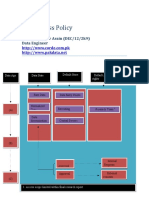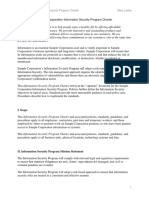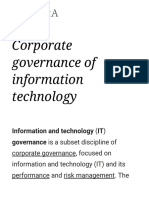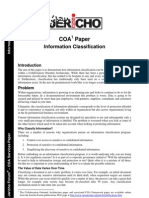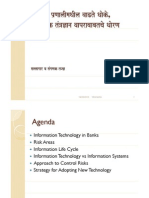Data Classification Policy
Uploaded by
AndyBaibData Classification Policy
Uploaded by
AndyBaibResponsible University Official: Chief Information Officer Responsible Office: Information Systems and Services Origination Date: April
12, 2004
DATA CLASSIFICATION SECURITY POLICY Policy Statement
All members of the University community have a responsibility to protect University data from unauthorized generation, access, modification, disclosure, transmission or destruction, and are expected to be familiar with and comply with this policy. Violations of this policy can lead to disciplinary action up to and including dismissal, expulsion, and/or legal action. Any known violations of this policy are to be reported to the University's Chief Information Security Officer.
Reason for Policy/Purpose
To educate the University community about the importance of protecting data generated, accessed, transmitted and stored by the University, to identify procedures that should be in place to protect the confidentiality, integrity and availability of University data, and to comply with local and federal regulations regarding privacy and confidentiality of information.
Who Needs To Know This Policy
Faculty, staff and students
Table of Contents
Policy Statement ................................................................................................. 1 Reason for Policy/Purpose .................................................................................. 1 Who Needs to Know This Policy ........................................................................ 1 Table of Contents ................................................................................................ 1 Policy/Procedures ................................................................................................ 2 Website Address.................................................................................................. 5 Contacts ............................................................................................................... 5 Related Information ............................................................................................ 6 Who Approved This Policy................................................................................. 6 History/Revision Dates ....................................................................................... 6
DATA CLASSIFICATION SECURITY POLICY
Policy/Procedures
I. RESPONSIBILITY FOR DATA MANAGEMENT
Data is a critical asset of the University. All members of the University community have a responsibility to protect the confidentiality, integrity, and availability of data generated, accessed, modified, transmitted, stored or used by the University, irrespective of the medium on which the data resides and regardless of format (such as in electronic, paper or other physical form). Departments are responsible for implementing appropriate managerial, operational, physical, and technical controls for access to, use of, transmission of, and disposal of University data in compliance with this policy. Data owned, used, created or maintained by the University is classified into the following three categories: Public Official Use Only Confidential
Departments should carefully evaluate the appropriate data classification category for their information. When provided in this policy, examples are illustrative only, and serve as identification of implementation practices rather than specific requirements. Nothing in this policy is intended to identify a restriction on the right of departments to require policies and/or procedures in addition to the ones identified in this document. II. DATA CLASSIFICATIONS A. PUBLIC DATA
Public data is information that may or must be open to the general public. It is defined as information with no existing local, national or international legal restrictions on access or usage. Public data, while subject to University disclosure rules, is available to all members of the University community and to all individuals and entities external to the University community. By way of illustration only, some examples of Public Data include: Publicly posted press releases Publicly posted schedules of classes
DATA CLASSIFICATION SECURITY POLICY Publicly posted interactive University maps, newsletters, newspapers and magazines OFFICIAL USE ONLY DATA
B.
Official Use Only Data is information that must be guarded due to proprietary, ethical, or privacy considerations, and must be protected from unauthorized access, modification, transmission, storage or other use. This classification applies even though there may not be a civil statute requiring this protection. Official Use Only Data is information that is restricted to members of the University community who have a legitimate purpose for accessing such data. By way of illustration only, some examples of Official Use Data include: Employment data University partner or sponsor information where no more restrictive confidentiality agreement exists Internal telephone books and directories
Official Use Only data: Must be protected to prevent loss, theft, unauthorized access and/or unauthorized disclosure. Must be stored in a closed container (i.e. file cabinet, closed office, or department where physical controls are in place to prevent disclosure) when not in use. Must not be posted on any public website. Must be destroyed when no longer needed subject to the Universitys Records Management Policy. Destruction may be accomplished by: o "Hard Copy" materials must be destroyed by shredding or another process that destroys the data beyond either recognition or reconstruction. After destruction, materials may be disposed of with normal waste. o Electronic storage media shall be sanitized appropriately by overwriting or degaussing prior to disposal. Disposal of electronic equipment must be performed in accordance with the Universitys Electronic Equipment Recycling Policy. C. CONFIDENTIAL DATA
Confidential Data is information protected by statutes, regulations, University policies or contractual language. Managers may also designate data as Confidential. Confidential Data may be disclosed to individuals on a need-to-know basis only. Disclosure to parties outside the University should be authorized by executive management and/or the Vice President and General Counsel.
DATA CLASSIFICATION SECURITY POLICY By way of illustration only, some examples of Confidential Data include: Medical records Student records and other non-public student data Social Security Numbers Personnel and/or payroll or records Bank account numbers and other personal financial information Any data identified by government regulation to be treated as confidential, or sealed by order of a court of competent jurisdiction.
Confidential data: When stored in an electronic format, must be protected with strong passwords and stored on servers that have protection and encryption measures provided by DivIT in order to protect against loss, theft, unauthorized access and unauthorized disclosure. Must not be disclosed to parties without explicit management authorization. Must be stored only in a locked drawer or room or an area where access is controlled by a guard, cipher lock, and/or card reader, or that otherwise has sufficient physical access control measures to afford adequate protection and prevent unauthorized access by members of the public, visitors, or other persons without a need-to-know. When sent via fax must be sent only to a previously established and used address or one that has been verified as using a secured location. Must not be posted on any public website. Must be destroyed when no longer needed subject to the Universitys Records Management Policy. Destruction may be accomplished by: o "Hard Copy" materials must be destroyed by shredding or another process that destroys the data beyond either recognition or reconstruction. After destruction, materials may be disposed of with normal waste. o Electronic storage media shall be sanitized appropriately by degaussing prior to disposal. Disposal of electronic equipment must be performed in accordance with the Universitys Electronic Equipment Recycling Policy. The Office of the Chief Security Officer must be notified in a timely manner if data classified as Confidential is lost, disclosed to unauthorized parties or suspected of being lost or disclosed to unauthorized parties, or if any unauthorized use of the University's information systems has taken place or is suspected of taking place. III. DATA CLASSIFICATION ROLES AND RESPONSIBILITIES
The Division of Information Technology is the primary entity charged with developing policy and procedures subordinate to and in support of this policy.
DATA CLASSIFICATION SECURITY POLICY The Office of the Chief Information Officer is charged with the promotion of security awareness within the University community, as well as responsibility for the creation, maintenance, enforcement and design of training on relevant security standards in support of this policy. The Chief Information Officer will receive and maintain reports of incidents, threats and malfunction that may have a security impact on the University's information systems, and will receive and maintain records of actions taken or policies and procedures developed in response to such reports. The Chief Information Officer will assist the Internal Audit Department, as appropriate, in conducting periodic audits to determine University compliance with this policy. The University Compliance & Privacy Office will facilitate distribution of this policy, will assist in the investigation of policy breaches, and will administer the Universitys 24 hour Regulatory Compliance Help and Referral Line (1-888-508-5275), which provides a confidential method for reporting instances of suspected misconduct or violations of law or University policies. The Office of the Vice President and General Counsel will review procedures issued under authority of this policy for compliance with applicable regulations. General Counsel will also respond to court ordered releases of information.
Website Address for This Policy
GW University Policies
Contacts
Subject Security Questions Contact Phone Division of IT Help Desk 202-994-4948 http://it.gwu.edu http://helpdesk.gwu.edu Reporting Security Incidents Information Security Services 703-726-4412 abuse@gwu.edu E-mail ithelp@gwu.edu
http://it.gwu.edu/tnav/stayconnected/security/ReportSecurityIncident/ Compliance & Privacy Office 202-994-3386 comply@gwu.edu
Regulatory Compliance Help and Referral Line
1-888-508-5275
DATA CLASSIFICATION SECURITY POLICY
Related Information
Family Educational Rights and Privacy Act of 1974 (FERPA) Health Insurance Information Portability and Accountability Act (HIPAA) George Washington University Privacy Policy Statement Information Security Policy Privacy of Student Records Policy Records Management Policy Social Security Number Usage Policy
Who Approved This Policy
Robert A. Chernak, Senior Vice President for Student and Academic Support Services Louis H. Katz, Executive Vice President and Treasurer Donald R. Lehman, Executive Vice President for Academic Affairs Beth Nolan, Senior Vice President and General Counsel John F. Williams, Provost and Vice President for Health Affairs
Who Approved This Policy
Origination Date: Last Amended Date: Next Review Date: April 12, 2004 December 6, 2005 February 28, 2012
You might also like
- Software Asset Management: What Is It and Why Do I Need It?: A Textbook on the Fundamentals in Software License Compliance, Audit Risks, Optimizing Software License ROI, Business Practices and Life Cycle ManagementFrom EverandSoftware Asset Management: What Is It and Why Do I Need It?: A Textbook on the Fundamentals in Software License Compliance, Audit Risks, Optimizing Software License ROI, Business Practices and Life Cycle ManagementNo ratings yet
- UCL Corporate Digital Data Ownership and Access PolicyNo ratings yetUCL Corporate Digital Data Ownership and Access Policy9 pages
- Data Policy: What Kind of Information Do We Collect?No ratings yetData Policy: What Kind of Information Do We Collect?12 pages
- Corporate Governance of Information Technology - WikipediaNo ratings yetCorporate Governance of Information Technology - Wikipedia24 pages
- CCISO EC Council Chief Information Security OfficerNo ratings yetCCISO EC Council Chief Information Security Officer13 pages
- Prudential Practice Guide CPG 234 Management of Security Risk May 2013No ratings yetPrudential Practice Guide CPG 234 Management of Security Risk May 201329 pages
- GDPR Consent To Collect Data From European Union Students PDFNo ratings yetGDPR Consent To Collect Data From European Union Students PDF2 pages
- ISO27k Information Classification GuidelineNo ratings yetISO27k Information Classification Guideline1 page
- Information Security Handbook For EmployeesNo ratings yetInformation Security Handbook For Employees13 pages
- Chapter 1 Computer Security Incident ResponseNo ratings yetChapter 1 Computer Security Incident Response12 pages
- Tb-Discussing Data - Evaluating Data QualityNo ratings yetTb-Discussing Data - Evaluating Data Quality12 pages
- Privacy Notice For Prospective EmployeesNo ratings yetPrivacy Notice For Prospective Employees5 pages
- Data Protection Checklist: Research and Related Activities: What Is Personal Data?No ratings yetData Protection Checklist: Research and Related Activities: What Is Personal Data?4 pages
- Defradar - Data Protection Impact Assessment Questionnaire100% (2)Defradar - Data Protection Impact Assessment Questionnaire4 pages
- Guide To Data Governance Part1 The Case For Data Governance WhitepaperNo ratings yetGuide To Data Governance Part1 The Case For Data Governance Whitepaper23 pages
- Generally Accepted Privacy Principles (GAPP) CIPP GuideNo ratings yetGenerally Accepted Privacy Principles (GAPP) CIPP Guide4 pages
- Certified Information Privacy Technologist A Complete GuideFrom EverandCertified Information Privacy Technologist A Complete GuideNo ratings yet
- GDPR Guidance Legitimate Interests Sample Lia Template100% (1)GDPR Guidance Legitimate Interests Sample Lia Template5 pages
- Introduction To Enterprise Data ManagementNo ratings yetIntroduction To Enterprise Data Management5 pages
- Business Continuity Management: Building an Effective Incident Management PlanFrom EverandBusiness Continuity Management: Building an Effective Incident Management PlanNo ratings yet
- Software Asset Management: What Is It and Why Do I Need It?: A Textbook on the Fundamentals in Software License Compliance, Audit Risks, Optimizing Software License ROI, Business Practices and Life Cycle ManagementFrom EverandSoftware Asset Management: What Is It and Why Do I Need It?: A Textbook on the Fundamentals in Software License Compliance, Audit Risks, Optimizing Software License ROI, Business Practices and Life Cycle Management
- UCL Corporate Digital Data Ownership and Access PolicyUCL Corporate Digital Data Ownership and Access Policy
- Data Policy: What Kind of Information Do We Collect?Data Policy: What Kind of Information Do We Collect?
- Corporate Governance of Information Technology - WikipediaCorporate Governance of Information Technology - Wikipedia
- CCISO EC Council Chief Information Security OfficerCCISO EC Council Chief Information Security Officer
- Prudential Practice Guide CPG 234 Management of Security Risk May 2013Prudential Practice Guide CPG 234 Management of Security Risk May 2013
- GDPR Consent To Collect Data From European Union Students PDFGDPR Consent To Collect Data From European Union Students PDF
- Data Protection Checklist: Research and Related Activities: What Is Personal Data?Data Protection Checklist: Research and Related Activities: What Is Personal Data?
- Defradar - Data Protection Impact Assessment QuestionnaireDefradar - Data Protection Impact Assessment Questionnaire
- Guide To Data Governance Part1 The Case For Data Governance WhitepaperGuide To Data Governance Part1 The Case For Data Governance Whitepaper
- Generally Accepted Privacy Principles (GAPP) CIPP GuideGenerally Accepted Privacy Principles (GAPP) CIPP Guide
- Certified Information Privacy Technologist A Complete GuideFrom EverandCertified Information Privacy Technologist A Complete Guide
- GDPR Guidance Legitimate Interests Sample Lia TemplateGDPR Guidance Legitimate Interests Sample Lia Template
- Business Continuity Management: Building an Effective Incident Management PlanFrom EverandBusiness Continuity Management: Building an Effective Incident Management Plan








